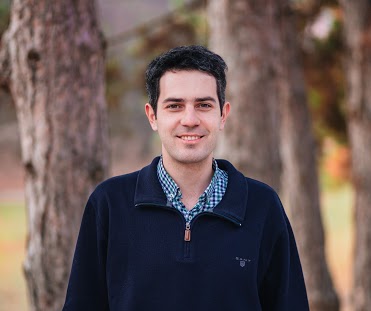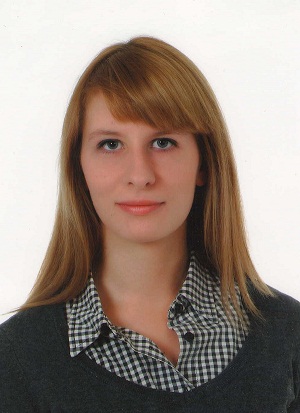 Svetlana Abramova Svetlana Abramova
Security and Privacy in Online Payment Systems: Empirical and Theoretical Perspectives
The cumulative dissertation applies a number of proven methods from the computer science and IS literature to shed light on security and privacy behaviour of end users. How do users interact with online payment systems, what complex decisions do they make when being exposed to cyber and privacy risk? On one end of the spectrum, this work focuses on well-established online banking and online shopping services and, on the other, on innovative cryptocurrencies built on completely different architectural principles. |
 Adrian Dabrowski Adrian Dabrowski
Security and Privacy in Large-scale Infrastructure
Large-scale infrastructure has some unique challenges when it comes to security: It’s an ecosystem of different vendors, long-term investments & life-cycles, and surprising interactions between different components and standards. For this thesis I pick cellular phone networks, power grids, and barcodes. |
 Luca Debiasi Luca Debiasi
PRNU-based Detection of Morphed Face Images
The use of deep neural networks (DNN) for face recognition paved the way to include face recognition into various applications, ranging from mobile device authentication to automatic border control. However, the use of DNNs leads to an increased vulnerability to presentation attacks. In order to address face morphing attacks, a type of presentation attack, a detection system based on the analysis of Photo Response Non-Uniformity (PRNU) has been developed. |
 Amra Delic Amra Delic
Group decision-making in the eTourism domain
We have all found ourselves trying to decide on a next destination that we would like to visit with our friends or family. Interestingly, some people in a group always seem to get it their way, some are keen to make sure everybody in the group is happy about a decision, while some people are impossible to please. How all this is related to preferences, personality, as well as, social relationships in group settings will be explored in this work. We will dive deep into the group decision-making process and discuss what should be considered when building recommender systems to truly help groups in their travel decision-making process. |
 Barbara Göbl Barbara Göbl
A Participatory Approach to a Mobile Serious Game to Foster Social Media Literacy
This thesis is part of an interdisciplinary project aiming to develop a mobile serious game that elaborates on the issues and potentials of social media in young people’s lives. For our learning game, we evaluate the application of modern interaction methods, such as dialog systems, and closely collaborate with adolescents to design game elements as well as set suitable learning goals. |
 Gramoz Goranci Gramoz Goranci
Dynamic Graph Algorithms and Graph Sparsification: New Techniques and Connections
In Dynamic Graph Algorithms, the goal is to maintain fundamental graph primitives such as shortest path, electrical flow, and maximum flow under insertions and deletions of edges. In Graph Sparsification, the goal to ”compress” large graphs and retain information about distances, graph spectrum, and cut structure. In this thesis, we (i) develop new algorithmic techniques for solving a multitude of graph-based optimization problems from both dynamic and sparsification perspective, and (ii) introduce novel reduction techniques that show unexpected connections between these two seemingly different areas of modern algorithm design. |
 Pasquale Grippa Pasquale Grippa
Drone Delivery Systems
Autonomous multi-drone systems dramatically reduce the cost of transporting goods from the last dispatch center to the delivery point, thus solving the last-mile problem. To provide high quality of service, the system requires correct infrastructure dimensioning and intelligent drone coordination: one drone can make the difference between receiving a good in short time and waiting for hours. This dissertation addresses both the dimensioning and the coordination challenges. We compute the minimum investment needed to achieve a targeted quality of service and introduce a novel policy to efficiently assign delivery requests to drones. |
 Kerstin Hammernik Kerstin Hammernik
Variational Networks for Medical Image Reconstruction
While machine learning has shown a great potential for segmentation and classification tasks not only in computer vision but also in medical imaging, the application of machine learning to medical image reconstruction is rather new. In this work, we explore Variational Networks that connect two successful fields, variational models and deep learning, for various medical image reconstruction tasks ranging from limited-angle CT to the reconstruction of static and dynamic MRI data.
Using the proposed Variational Networks, we achieve promising results in terms of improved image quality and reduced artifacts that arise during the acquisition process, consequently, this new approach to image reconstruction offers the potential to be directly integrated into the clinical workflow and improve patient comfort, patient safety and healthcare costs. |
 Martin Häusler Martin Häusler
A NoSQL Model Repository for Scalable Model Versioning, Querying & Persistence
The PhD Thesis “A NoSQL Model Repository for Scalable Model Versioning, Querying & Persistence” introduces a novel generic method for collaboration on large models under version control by utilizing NoSQL data storage. The Thesis provides a detailed requirement analysis derived from an industrial context, an architectural solution overview, benchmarks and an industrial case study, as well as an open-source proof-of-concept prototype implementation of the developed concepts. |
![]() Christoph Hofer Christoph Hofer
Computational Topology in Machine Learning – Connecting the Dots
This short talk will outline recent advances in connecting the fields of computational topology and machine learning. In particular, we will discuss how we can learn representations of topological signatures of data in a neural network context and how to enforce certain topological characteristics on representations learned by such networks. |
 Daniela Kaufmann Daniela Kaufmann
Circuit Verification
Automated formal verification of arithmetic circuits used to implement arithmetic units in processors or cryptographic functions is an important problem, which in practice still requires substantial manual effort to be applicable in circuit design. Especially proving the correctness of multiplier circuits is considered to be hard and cannot be done fully automated. In my thesis I work on the application of computer algebra techniques to make formal verification of arithmetic circuits practically applicable for large scale non-trivial and optimized multiplier designs. |
 Ema Kusen Ema Kusen
Emotion-exchange motifs: Uncovering the basic building blocks of emotion-annotated communication networks
Observable user behavior in online social networking platforms has revealed that emotional content attracts more attention and diffuses further in the network than the emotionally neutral one. The question however remains how emotions contribute to the formation of communication links between users. In my thesis, I uncover the statistically significant structural patterns mined from real-world emotion-annotated communication networks and propose a concept called “emotion-exchange motifs” to reveal distinctive communication patterns for human accounts and automated bot accounts. |
 David Leopoldseder David Leopoldseder
Simulation-based Code Duplication in a Dynamic Compiler
Compilers are an integral part of programming languages: it is their responsibility to produce fast, small and efficient code for even the most complex programs. In my thesis I introduce “Simulation-Based Code Duplication”, a novel optimization for just-in-time compilers that significantly improves the performance of generated machine code. Parts of my work have been integrated into Oracle’s recently released GraalVM Enterprise 19.0 Virtual Machine. |
 Christian Macho Christian Macho
Preventing and Repairing Build Breakage
Build systems are an integral part of modern software engineering processes to regularly integrate new features and to deliver them to the customers automatically. Breaking this delivery pipeline can be a costly failure as necessary features might be delayed because the development team has to focus on repairing the delivery service first. This thesis investigates novel methods to prevent future breaks and automatically repair already broken builds. |
 Sebastian Neumaier Sebastian Neumaier
Semantic Enrichment of Open Data on the Web
Current Open Data lacks in sufficient data quality, rich/consistent descriptions, and uniform vocabularies. Having identified and measured the existing quality issues, we outline methods to restore the quality of published resources, methods to recover the semantics of tabular Open Data, and methods to extract taxonomic, spatial and temporal information. Eventually, the aim of this work is to improve the overall quality and value of Open Data and to use the extracted semantic information to build an Open Data Knowledge Graph. |
![]() Tiago Santos Tiago Santos
Evolution of Online Communities
Online knowledge communities on the Web, as ubiquitous large-scale knowledge repositories and up-to-date news sources, form around a vast number of topics and comprise millions of users. To support community building efforts, my research focuses on understanding and modeling how and why some of these online knowledge communities attract activity from large number of users, while others struggle and consequently shutdown. |
 Michael Schwarz Michael Schwarz
Software-based Side-Channel Attacks and Defenses in Restricted Environments
The main assumption of computer systems is that processed secrets are well protected by software and hardware. However, such security guarantees often do not hold in the case of side-channel attacks, which allow observing side effects of computation. In this thesis, we (1) reduce the requirements for side-channel techniques, which we used for discovering Meltdown, Spectre, and ZombieLoad, to enable side-channel attacks even from modern browsers and (2) present solutions to protect commodity systems from such powerful attacks. |
 Katta Spiel Katta Spiel
Evaluating Experiences of Autistic Children with Technologies in Co-Design
The concept of ‘Critical Experience’ offers a novel way for the evaluation of the experiences of autistic children with technologies that are designed for their holistic well-being and enjoyment. Additionally, I make a methodological contribution by showing how PEACE (Participatory Evaluation with Autistic ChildrEn) enables researchers to evaluate these technologies together with autistic children to gather insights into what is meaningful to them. |
 Josef Tkadlec Josef Tkadlec
Evolutionary graph theory is a framework for modelling how entities spread over a network, be it genetic mutations in spatially structured populations or opinions of Facebook users. In the thesis, we study the extent to which the network can alter the probability that a single invader (mutation, opinion) spreads through the whole network. We focus on genetic mutations and identify networks that enhance this probability, thereby speeding up evolution by allowing beneficial mutations to accumulate faster. |
|

 Svetlana Abramova
Svetlana Abramova Adrian Dabrowski
Adrian Dabrowski Luca Debiasi
Luca Debiasi Amra Delic
Amra Delic Barbara Göbl
Barbara Göbl Gramoz Goranci
Gramoz Goranci Pasquale Grippa
Pasquale Grippa Kerstin Hammernik
Kerstin Hammernik Martin Häusler
Martin Häusler Daniela Kaufmann
Daniela Kaufmann Ema Kusen
Ema Kusen David Leopoldseder
David Leopoldseder Christian Macho
Christian Macho Sebastian Neumaier
Sebastian Neumaier Michael Schwarz
Michael Schwarz Katta Spiel
Katta Spiel Josef Tkadlec
Josef Tkadlec